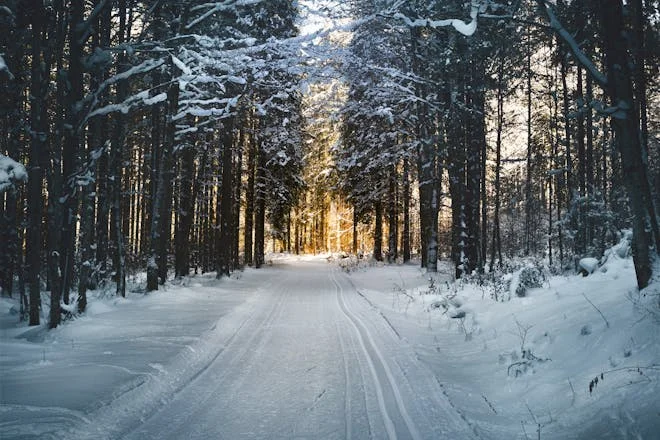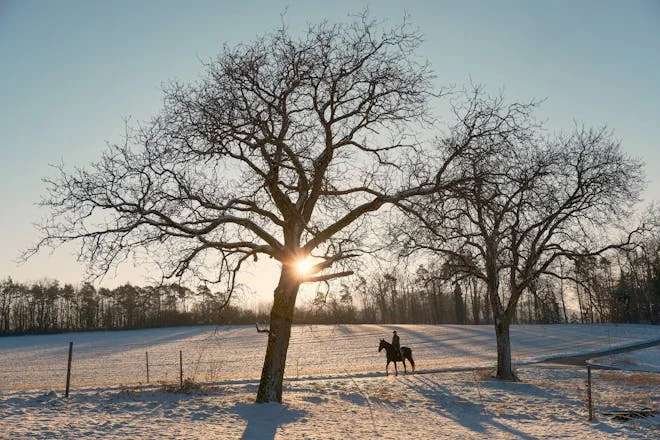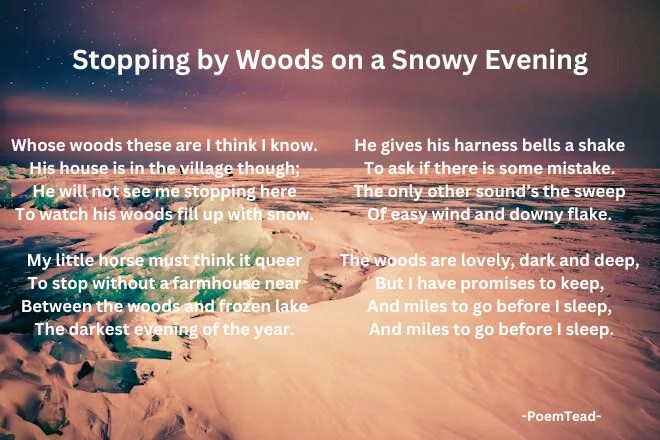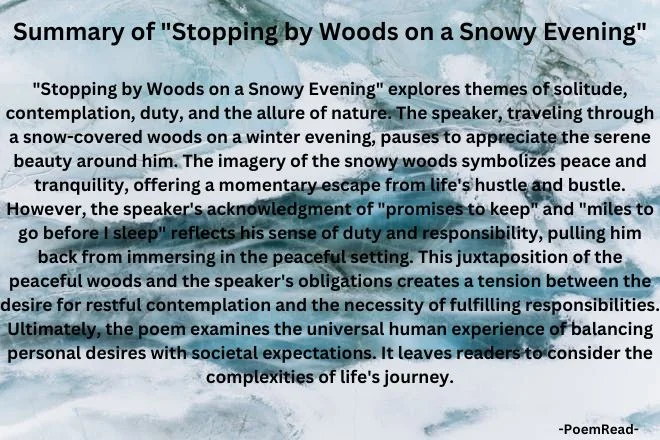
“Stopping by Woods on a Snowy Evening” by Robert Frost is one of those poems that sticks with you. It’s simple yet meaningful, capturing the beauty and mystery of a quiet winter night. In this article, we’ll dive deep into the poem’s subject, context, theme, tone, form, and structure. Whether you’re a literature student or just someone who loves poetry, this analysis will give you a fresh perspective on Frost’s masterpiece.
Stopping by Woods on a Snowy Evening
Whose woods these are I think I know.
His house is in the village though;
He will not see me stopping here
To watch his woods fill up with snow.
My little horse must think it queer
To stop without a farmhouse near
Between the woods and frozen lake
The darkest evening of the year.
He gives his harness bells a shake
To ask if there is some mistake.
The only other sound’s the sweep
Of easy wind and downy flake.
The woods are lovely, dark and deep,
But I have promises to keep,
And miles to go before I sleep,
And miles to go before I sleep.
Content
- About the Author
- Subject of “Stopping by Woods on a Snowy Evening”
- Context of “Stopping by Woods on a Snowy Evening”
- Theme and Tone of “Stopping by Woods on a Snowy Evening”
- Persona, Setting, and Narrative in "Stopping by Woods on a Snowy Evening"
- Form and Structure
- Line-by-Line Analysis of “Stopping by Woods on a Snowy Evening”
- Poetic and Literary Devices Used in “Stopping by Woods on a Snowy Evening”
- Implications and Meanings of “Stopping by Woods on a Snowy Evening”
- Interactive Summary
About the Author
Robert Frost, one of America’s most celebrated poets, was born on March 26, 1874, in San Francisco, California. After his father’s death in 1885, Frost’s family moved to Lawrence, Massachusetts, where his connection with New England began—a region that deeply influenced his poetry. He briefly attended Dartmouth College before working various jobs, including teaching and farming, which enriched his poetic material.
Frost’s literary career took off with the publication of his first book, “A Boy’s Will,” in 1913. His success continued with collections like “North of Boston” (1914), “Mountain Interval” (1916), and “New Hampshire” (1923), for which he won the first of his four Pulitzer Prizes. His works include famous poems like “The Road Not Taken,” “Mending Wall,” and “Birches,” exploring themes of nature, rural life, and human experience.
“Stopping by Woods on a Snowy Evening,” from the “New Hampshire” collection, exemplifies Frost’s mastery of simple yet profound language. The poem reflects the quiet beauty of a snowy evening and themes of solitude, contemplation, and time’s passage. Frost’s style is characterized by its use of plain language, vivid imagery, and a conversational tone. Through these elements, he delves into themes such as individualism, the human condition, and man’s relationship with nature, often drawing from his personal experiences.
Throughout his career, Frost received numerous accolades, including four Pulitzer Prizes and the Congressional Gold Medal. His contribution to American literature remains significant, with works celebrated for their insight, elegance, and enduring relevance.
Subject of “Stopping by Woods on a Snowy Evening”
At its core, “Stopping by Woods on a Snowy Evening” is about the allure of nature and the pull it exerts on the speaker. The poem’s subject is a reflection on the momentary pause in life to appreciate the quiet beauty of a snowy evening. The speaker, presumably on a journey, is drawn to the peaceful and mesmerizing scene of falling snow in the woods. This moment of tranquility stands in contrast to the speaker’s awareness of the “promises” that await him. These promises symbolize life’s responsibilities and tasks, often hindering us from savoring such serene moments.
The woods represent a place of escape and contemplation, away from the hustle and bustle of daily life. They offer a space for reflection and inner peace, inviting the speaker to linger. However, this desire to linger is tempered by the recognition that the speaker cannot neglect his responsibilities. The repeated line “And miles to go before I sleep” echoes this sentiment. This line serves as a reminder that, although we may long for respite and beauty, we must eventually return to our duties.
Essentially, the subject of this poem encapsulates a universal human experience—the conflict between our desire for peace and beauty, and the continuous demands of time and responsibility. It’s a reminder to find balance between appreciating life’s simple pleasures while also fulfilling our commitments.
Context of “Stopping by Woods on a Snowy Evening”
Robert Frost wrote “Stopping by Woods on a Snowy Evening” in 1922 and included it in his 1923 collection, “New Hampshire.” The poem features a traveler who pauses on the darkest evening of the year to admire snow-covered woods. Literally, it describes this serene moment in nature, while metaphorically, it explores themes of reflection and contemplation during life’s journey.
Frost wrote the poem after an exhausting night spent working on another piece, “New Hampshire.” As dawn broke, he looked out at the snowy landscape and found inspiration for this poem. This moment of creation reflects the weariness and introspection felt by both Frost and the poem’s speaker.
The early 1920s, a period of significant change and modernization, often led to feelings of disconnection from nature. Frost’s poem responds to this by emphasizing the need to reconnect with the natural world. Additionally, Frost’s personal experiences, marked by considerable tragedy and loss, shape the poem’s depiction of the woods as both beautiful and dark. This duality suggests both peace and melancholy.
Overall, the context of “Stopping by Woods on a Snowy Evening” is deeply rooted in Frost’s life and the societal shifts of his time. It captures a moment that is specific to Frost but has universal appeal. The poem invites readers to pause and reflect amid life’s relentless pace.
Theme and Tone of “Stopping by Woods on a Snowy Evening”
Theme
The poem “Stopping by Woods on a Snowy Evening” explores two main themes: the allure of nature and the responsibilities of life. It explores the conflict between wanting to remain in the tranquil beauty of nature, which the woods represent. This desire contrasts with fulfilling the demands of daily life, symbolized by the promises and obligations yet to be fulfilled.
On one hand, the poem beautifully captures the speaker’s attraction to the serene and mesmerizing woods, symbolizing a desire to escape from life’s pressures. However, this momentary pause is fleeting as the speaker remembers his responsibilities. The phrases “promises to keep” and “miles to go before I sleep” indicate this. This contrast underscores the common human desire for relaxation and tranquility amid life’s continuous demands.
Additionally, the poem touches on the contemplation of life and mortality. The woods can be interpreted as a metaphor for death or the unknown, inviting the speaker to embrace a quiet end. However, choosing to carry on with the journey shows a dedication to life and its responsibilities, even when tempted to find solace in rest.
The combination of themes—nature’s attraction, life’s duties, and the fleeting nature of time—provides a detailed examination of human experiences. It also explores the careful balance between finding comfort and meeting responsibilities.
Tone
The tone of Robert Frost’s “Stopping by Woods on a Snowy Evening” is thoughtful and introspective, carrying a subtle solemnity. The speaker maintains a calm and quiet demeanor throughout the poem, observing the peaceful snowfall and darkening woods. This tranquility is juxtaposed with a subtle tension arising from the speaker’s awareness of his obligations.
The poem begins with a gentle, almost hushed tone as the speaker describes his stop by the woods. The horse’s harness bells briefly disrupt the calmness, adding a hint of intrigue or mild disturbance. However, the overall serenity is quickly restored with the description of the “easy wind and downy flake.”
As the poem progresses to its conclusion, the tone becomes more introspective and slightly somber. The repetition of “And miles to go before I sleep” carries a weight of weariness and resolve. It reflects the speaker’s recognition of life’s relentless demands and his acceptance of the journey ahead. Frost’s deliberate word selection and structured rhyme scheme help create this reflective tone. Ultimately, it encourages readers to join the speaker in his brief pause and eventual determination to continue.
Persona, Setting, and Narrative in “Stopping by Woods on a Snowy Evening”

The persona in “Stopping by Woods on a Snowy Evening” is that of a contemplative traveler who is reflective and introspective. The speaker is traveling through a rural area on the darkest evening, pausing to admire nature’s beauty. This moment of appreciation is balanced by the speaker’s awareness of responsibilities, conveying both weariness and a sense of duty.
The poem is set in a secluded spot near snow-filled woods on a winter evening, hinting at tranquility and isolation. This setting contrasts with the implied busyness of the speaker’s life, adding depth to the poem. Furthermore, it establishes the mood, with silent, snow-covered woods contrasting the speaker’s inner conflict.
The narrative unfolds as a first-person account of the speaker’s brief stop by the woods. Beginning with observation, it progresses to an internal debate about staying or continuing the journey. Frost’s narrative style immerses readers in the speaker’s conflict and resolution, reflecting on the balance between rest and responsibilities.
Form and Structure
“Stopping by Woods on a Snowy Evening” is structured with four quatrains, each consisting of four lines. The poem adheres to a strict rhyme scheme of AABA BBCB CCDC DDDD. In this pattern, the third line of each stanza rhymes with the first, second, and fourth lines of the subsequent stanza. This interlocking rhyme scheme creates a sense of continuity and interconnection between stanzas.
The meter of the poem is iambic tetrameter, which means each line typically has four feet with an unstressed syllable followed by a stressed syllable. This meter gives the poem a rhythmic and steady pace that mirrors the trotting of the horse or the falling snowflakes.
The structured form of the poem contrasts with the fluidity of the natural scene it describes. This contrast may symbolize the conflict between the speaker’s wish to stay in the present moment and his obligation to meet societal expectations and personal responsibilities.
The repetition of the last line in the final stanza serves as a refrain, emphasizing the theme of ongoing duties and life’s journey. It also provides a sense of closure to the poem, reinforcing its contemplative mood.
Line-by-Line Analysis of “Stopping by Woods on a Snowy Evening”
First Stanza
In the first stanza of “Stopping by Woods on a Snowy Evening,” the speaker introduces the scene by acknowledging that he knows the owner of the woods residing in the nearby village. Despite this familiarity, he experiences a sense of anonymity and solitude, realizing that the owner won’t witness him pausing to admire the snow-filled woods.
This stanza introduces key themes of ownership and the contrast between nature and society. It also highlights the speaker’s internal conflict between duty and personal contemplation. The contemplative and introspective tone set here invites readers to join the speaker in his moment of pause and reflection amidst the snow-covered woods.
Whose woods these are I think I know.
The first line immediately establishes the speaker’s contemplative mood. The use of the possessive pronoun “whose” suggests the speaker’s curiosity about the ownership of the woods, hinting at a deeper inquiry into the ownership of nature itself.
The phrase “I think I know” indicates a sense of familiarity or recognition, implying that the speaker may have some connection to the owner of the woods or the area. Thus, this line sets the stage for the speaker’s internal dialogue and sets a tone of inquiry and introspection.
His house is in the village though;
The second line introduces the owner of the woods, who lives in the village. This detail highlights the separation between the busy village life and the quiet, isolated woods described later. The word “though” suggests a shift in focus, indicating that there’s more to the situation than initially apparent. This sets the stage for exploring the themes of societal obligations versus personal desires.
He will not see me stopping here
The third line reveals the speaker’s deliberate choice to pause and admire the woods. The word “stopping” indicates a purposeful action, showing that the speaker has intentionally taken a break from his journey to appreciate nature’s beauty.
The phrase “He will not see me” suggests a sense of secrecy or privacy in the speaker’s actions. It implies that the speaker is taking a moment for himself away from the watchful eyes of others. This line hints at the speaker’s internal struggle between meeting obligations, symbolized by the owner in the village, and taking time for personal reflection, symbolized by stopping in the woods.
To watch his woods fill up with snow.
The final line of the stanza introduces the imagery of snowfall, a central motif in the poem. Watching the woods “fill up with snow” portrays a tranquil and mesmerizing scene, highlighting nature’s beauty in its winter cloak.
The word “watch” conveys admiration and observation, showcasing the speaker’s appreciation for the evolving landscape as snow gradually accumulates. This gradual buildup mirrors the slow passage of time and the speaker’s brief pause in his journey.
By setting this imagery, the line prepares for the detailed descriptions in the following stanzas, creating a vivid picture of the snowy evening. It lays the groundwork for exploring the tension between stillness and progress, personal desire, and societal expectations in the poem.
Second Stanza

In the second stanza, the speaker acknowledges the peculiarity of his stop from his horse’s perspective. The horse likely finds it odd to pause in such a remote place, far from any farmhouse. The description of the setting with woods, a frozen lake, and the darkest evening of the year enhances the sense of solitude and the almost mystical aura of the scene.
This stanza expands on the themes introduced earlier, highlighting the isolation of the setting and the uncommon nature of the speaker’s halt. It intensifies the contemplative atmosphere by focusing on the natural elements surrounding the speaker and the darkness of the evening. Through these detailed descriptions and imagery, a clear and immersive ambiance is established. This sets the stage for the speaker’s deeper contemplation and resolution in subsequent stanzas.
My little horse must think it queer
The stanza opens with the speaker projecting thoughts onto his horse, suggesting a close connection and familiarity with the animal. The use of “must think it queer” indicates that the speaker is aware of the unusual nature of stopping without a clear reason. Then, the adjective “little” conveys a sense of affection and familiarity, emphasizing the bond between the speaker and his horse.
The horse is personified with the ability to think and find the situation “queer,” or strange. This introduces a new perspective on the speaker’s actions, emphasizing the unusual nature of the stop. The word “queer” suggests that stopping without a farmhouse nearby is unusual and not part of their regular routine. This deviation from the norm further emphasizes the speaker’s deliberate choice to pause and experience the moment, despite it being out of character or unexpected.
To stop without a farmhouse near
This line elaborates on why the horse might perceive the stop as unusual: there is no nearby farmhouse. The absence of such a structure implies a lack of practical reasons for stopping, like seeking shelter or visiting someone, typical in rural areas.
This detail reinforces the themes of solitude and isolation already introduced. It also enhances the feeling of tranquility and detachment from human activities, placing them in an environment untouched by domestic life. Frost employs the absence of a farmhouse to emphasize the deliberate pause in an unconventional spot. This highlights nature’s allure and its power to pull one away from human-made environments. This detail adds to the depth of solitude and tranquility, establishing the tone for the introspective and contemplative mood of the poem.
Between the woods and frozen lake
This line describes the specific location where the speaker has chosen to stop. It is a place situated between the woods and a frozen lake, which adds to the sense of stillness and silence in the scene. The mention of a “frozen lake” also contributes to the wintry atmosphere and suggests a moment frozen in time.
The preposition “between” implies a threshold or boundary, which can be interpreted metaphorically as well. The speaker is caught between two elements of nature, perhaps symbolizing a choice or a balance between different paths or states of being.
This line enhances the poem’s setting by providing a more detailed image of the landscape. It invites readers to visualize and feel the cold, quiet environment that has captivated the speaker.
The darkest evening of the year.
The phrase “darkest evening of the year” holds a dual meaning. Literally, it points to the winter solstice, the longest night of the year. Metaphorically, it implies a period of deep contemplation, possibly tinged with melancholy.
This line brings a solemn tone to the poem, highlighting the hushed and reflective atmosphere during the speaker’s pause in the woods. The darkness intensifies the feeling of being alone and deep in thought. It prompts readers to reflect on the symbolic implications of darkness, such as mystery, moments of rest, or even mortality.
Third Stanza
The third stanza focuses on the horse’s reaction, shaking its harness bells as if questioning the stop. Aside from the soft fall of snowflakes and the gentle swish of the wind, there is only this tiny, jingling noise. This interaction adds to the tranquil and introspective mood of the poem, enhancing the themes of solitude and contemplation.
The detailed descriptions of the natural sounds further immerse the reader in the scene. The gentle, almost hypnotic imagery of the wind and snow invites readers to pause and reflect along with the speaker. The stanza captures the quiet beauty of the winter scene. It also conveys the subtle tension between the speaker’s moment of rest and the implied continuation of his journey.
He gives his harness bells a shake
This line brings the focus back to the horse, emphasizing its presence and awareness. The action of shaking the harness bells suggests a sense of impatience or confusion. The sound of the bells contrasts with the quietness of the woods and serves as a reminder of the world outside this moment of stillness. It can also be seen as a call back to reality for the speaker, who is lost in contemplation.
The use of “he” personalizes the horse, reinforcing the close relationship between the speaker and the animal. The use of “gives” suggests a deliberate action by the horse, further personifying it and adding to the poem’s charm.
This line contributes to the narrative by introducing movement and sound into the otherwise silent setting. Therefore, the sound of the bells introduces an auditory element to the poem, breaking the silence described in the previous stanzas.
To ask if there is some mistake.
The speaker attributes human-like curiosity or concern to the horse, imagining that it is questioning the unusual stop.
This anthropomorphism adds depth to the narrative, highlighting the contrast between the horse’s practical instincts and the speaker’s contemplative pause. It also underscores the unusual nature of the situation, as stopping in such a remote and quiet place seems out of the ordinary.
The word “mistake” implies confusion or doubt, reflecting on the speaker’s unusual decision to pause in his journey. It adds introspection, suggesting the speaker may question his own motives and actions through the horse’s perceived inquiry. This line deepens the interaction between the speaker and his horse, highlighting their companionship. It also emphasizes the horse’s role as an active participant in the journey, even if only through implied communication.
The only other sound’s the sweep
This line shifts the focus to the surrounding environment, emphasizing the silence of the scene. It describes the quietness of the scene by stating that the only other sound, apart from the harness bells, is the sweep of easy wind and downy flake. The use of “sweep” conveys a gentle, continuous movement, which complements the serene atmosphere.
The word “only” emphasizes the stillness and silence of the woods, suggesting that these subtle sounds are noticeable only because of the absence of other noises. It creates a sense of peace and calmness, allowing the reader to imagine the soft sounds of nature.
This line contributes to the overall mood by focusing on auditory imagery. It draws attention to the natural sounds that accompany the visual beauty of the snowy woods.
Of easy wind and downy flake.
This line completes the description started in the previous line, identifying the “sweep” as being caused by an “easy wind” and “downy flake.” The adjective “easy” suggests a gentle, unhurried wind, while “downy flake” evokes images of soft, light snowflakes.
Together, these phrases create a vivid sensory experience for the reader, emphasizing the gentle and tranquil nature of the scene. The wind and snowflakes are personified as performing a quiet dance, adding to the poem’s meditative quality.
This line further develops the peaceful setting, contrasting with the journey’s implied urgency and the speaker’s responsibilities that await beyond the woods.
Fourth Stanza
The fourth stanza brings the poem to a touching conclusion, balancing the speaker’s momentary enchantment with the woods against his strong sense of duty. The imagery of the “lovely, dark and deep” woods captures the reader’s imagination. Despite their allure, the speaker reminds himself of his obligations, symbolized by “promises to keep” and “miles to go before I sleep.”
The repetition of the final line emphasizes the speaker’s sense of duty and the ongoing journey ahead. This grounding in reality highlights the responsibilities he faces. The stanza captures the central theme of the poem, which is the tension between the allure of rest and contemplation and the necessity to continue life’s journey. Frost’s use of simple yet meaningful language ensures that the poem resonates on both a literal and metaphorical level. This makes it a timeless reflection on the human experience.
The woods are lovely, dark and deep,
This line begins with an affirmation of the beauty and allure of the woods. The adjectives “lovely,” “dark,” and “deep” convey a sense of mystery and tranquility. The use of these words also emphasizes the seductive nature of the woods, inviting the speaker to stay and explore further.
The phrase “dark and deep” adds to the sense of depth and complexity, suggesting that the woods represent more than just a physical space. They may symbolize the unknown, the subconscious, or even death. Further, this line displays the central tension in the poem: the desire to stay and enjoy the peaceful beauty. It contrasts with the demands of life that compel one to move on.
But I have promises to keep,
The word “But” introduces a contrast, signaling a shift from the tempting allure of the woods to the speaker’s sense of responsibility. “Promises to keep” implies obligations or duties that the speaker must fulfill, which could be personal, social, or moral commitments. This line reflects the tension between the desire to escape into the peaceful, enchanting woods and the necessity to continue with life’s responsibilities.
And miles to go before I sleep,
This line is repeated twice, emphasizing its importance and weight. “Miles to go” suggests a long journey ahead, both literally and metaphorically. It indicates that the speaker has much to accomplish before he can rest. “Sleep” can be interpreted as literal sleep, but it also carries a metaphorical meaning, potentially symbolizing death or the final rest.
And miles to go before I sleep.
The repetition of this line serves to reinforce the speaker’s resolve and commitment to his responsibilities. It also creates a rhythmic and hypnotic effect, mirroring the ongoing nature of the journey and the repetitive tasks of life. The repetition underscores the inevitability of duty and the persistence required to fulfill one’s obligations.
By repeating the line, Frost allows for a deeper contemplation of its themes. The reader is invited to consider again the journey ahead and what it symbolizes. The repetition also provides closure to the poem. It’s as if the narrator is convincing himself to move on from the tranquil scene before him.
Poetic and Literary Devices Used in “Stopping by Woods on a Snowy Evening”

Rhyme Scheme and Meter
Rhyme Scheme: The poem follows an AABA rhyme scheme, with the third line of each stanza carrying the rhyme to the next stanza. The final stanza has a DDDD rhyme scheme, creating a sense of closure. This interlocking rhyme scheme enhances the flow and musicality of the poem, making it pleasing to the ear and easy to memorize.
Meter: Frost employs iambic tetrameter, which means each line typically consists of four iambic feet (an unstressed syllable followed by a stressed syllable). This meter gives the poem a rhythmic and steady pace, mirroring the calm and methodical nature of the speaker’s journey.
Imagery
In Robert Frost’s “Stopping by Woods on a Snowy Evening,” imagery serves as a cornerstone in creating an immersive poetic experience. Frost expertly employs various types of imagery to craft a detailed portrayal of the wintry landscape, creating emotional responses and conveying deeper meanings.
The poem is rich in visual imagery, depicting the serene snow-covered woods vividly. For instance, lines such as “Whose woods these are I think I know” and “To watch his woods fill up with snow” create a mental image of snow-covered trees and the gradual change in the scenery.
Auditory imagery adds another layer of sensory experience, with the sound of the horse’s harness bells and the gentle sweep of the wind and snowflakes enhancing the poem’s atmosphere. These auditory cues immerse readers in the quietude and peacefulness of the snowy evening.
While primarily focusing on visual and auditory imagery, Frost subtly incorporates tactile elements, allowing readers to feel the coldness of snowflakes and the softness of freshly fallen snow.
Emotional imagery is a key feature of the poem. The snowy woods symbolize peace and serenity, while the speaker’s sense of duty brings forth feelings of responsibility and obligation.
Symbolic imagery further enriches the poem. Snow symbolizes purity and innocence, while the dark woods symbolize the unknown. The horse symbolizes companionship and loyalty, adding depth to the thematic exploration of the poem.
Overall, Frost’s masterful use of imagery creates a multi-sensory experience that transports readers to the wintry woods, inviting contemplation of nature, solitude, and the human condition.
Symbolism
Symbolism plays a crucial role in “Stopping by Woods on a Snowy Evening,” enriching the poem with deeper layers of meaning and contributing to its thematic exploration. Several elements in the poem serve as potent symbols, inviting readers to interpret the text beyond its literal description.
The woods themselves symbolize various aspects, depending on the interpretation. They can represent nature’s beauty and tranquility, offering a momentary escape from the demands of life. At the same time, the woods can symbolize the unknown, the mysterious, or even death, as they are described as “lovely, dark and deep.” This dual symbolism creates a sense of allure and danger, prompting readers to contemplate the complexities of existence and the human experience.
The snow in the woods is another powerful symbol, representing purity, stillness, and the passage of time. The imagery of the snow-covered landscape creates a serene and ethereal atmosphere, inviting introspection and reflection.The snowflakes serve as symbols for individual moments, each distinct yet contributing to an ongoing cycle. This metaphor reflects the transient quality of life and the certainty of change.
The horse in the poem can be interpreted as a symbol of responsibility and duty. Its restlessness and reluctance to atay in the woods mirror the speaker’s internal conflict. This conflict is between the desire for peaceful contemplation and the obligation to fulfill responsibilities. The horse’s actions symbolize the tension between personal desires and external expectations, adding depth to the poem’s exploration of human emotions and choices.
Furthermore, the setting of the darkest evening of the year symbolizes challenges, uncertainty, and the inevitability of facing darkness in life. It serves as a metaphorical backdrop for the speaker’s contemplation and decision-making process. This setting highlights themes of perseverance, resilience, and the ongoing journey through life’s trials and tribulations.
metaphors
In “Stopping by Woods on a Snowy Evening,” Robert Frost uses metaphors to deepen the poem’s themes and imagery.
One key metaphor is the depiction of the woods as a symbol for life’s challenges and mysteries. The line “The woods are lovely, dark and deep” metaphorically represents the captivating yet complex nature of life. “Lovely” conveys its enchanting aspects, while “dark and deep” suggests its significant and sometimes daunting aspects. This metaphor invites readers to reflect on the complexities of their own lives.
Another metaphor is seen in the description of the frozen lake and the darkest evening of the year. The frozen lake symbolizes obstacles or stagnation, while the darkest evening signifies challenges or moments of uncertainty. These metaphors add depth to the speaker’s contemplation and decision-making.
Additionally, the repeated line “And miles to go before I sleep” serves as a metaphor for the ongoing journey and responsibilities in life. “Miles to go” metaphorically represents the distance and effort needed to fulfill duties and achieve goals, emphasizing themes of duty and perseverance.
Repetition
Repetitions in “Stopping by Woods on a Snowy Evening” serve as a powerful literary device that reinforces key themes and emotions, creating rhythm and emphasis within the poem. One of the most notable repetitions is the final line of the poem, “And miles to go before I sleep.”
This repeated phrase acts as a refrain, emphasizing the speaker’s sense of duty and reminding readers of the ongoing journey and responsibilities in life. The repetition of “miles to go” underscores the long road ahead, both literally and metaphorically. It symbolizes the endurance required to fulfill commitments and achieve goals.
Contrast
In “Stopping by Woods on a Snowy Evening,” Robert Frost masterfully utilizes contrast as a central literary device to highlight the themes of contemplation, duty, and the human experience.
One of the most evident contrasts in the poem lies in the serene, snow-filled woods versus the speaker’s sense of duty and responsibility. The tranquil imagery of the woods, described as “lovely, dark and deep,” creates a peaceful and enchanting atmosphere. This contrasts sharply with the speaker’s acknowledgment of his obligations: “But I have promises to keep, / And miles to go before I sleep.” This stark contrast between the beauty and allure of nature and the pressing demands of life highlights the tension. It emphasizes the struggle between the desire for restful contemplation and the necessity of fulfilling responsibilities.
Another contrast is presented through the setting itself. The snow-covered woods symbolize solitude, tranquility, and a momentary escape from the busyness of life. The mention of the darkest evening of the year, as well as the absence of a farmhouse nearby, suggest isolation and deep calmness. This contrast between the peacefulness of nature and the potential loneliness or darkness of the setting adds depth to the poem’s mood and thematic exploration.
Furthermore, Frost contrasts the speaker’s internal contemplation with the external world, represented by the horse and the woods. While the speaker is drawn to pause and reflect, the horse’s actions, such as shaking its harness bells, signify a desire to move forward and continue the journey. This internal-external contrast highlights the complexity of human emotions and decisions, showcasing the interplay between personal introspection and external responsibilities.
Personification
Personification is a literary device where human characteristics are attributed to non-human entities or objects. In this poem, Robert Frost masterfully utilizes personification to animate the wintry landscape, infusing the poem with depth and emotional resonance.
One notable example of personification in the poem is the portrayal of the woods themselves. Frost writes, “The woods are lovely, dark and deep.” Here, the woods are personified as having the qualities of being “lovely” and “dark,” giving them a sense of mystery and allure. Personification in the poem transforms the woods into living entities, giving them distinct characteristics and moods. This allows readers to perceive them beyond mere physical surroundings.
Additionally, the horse in the poem is personified through its actions and reactions. For instance, the speaker notes, “My little horse must think it queer / To stop without a farmhouse near.” Frost humanizes the horse by attributing thoughts and feelings to it, which helps readers empathize with the animal’s perspective. This allows us to understand its curiosity or confusion regarding the unexpected stop in the snowy woods.
Furthermore, the imagery of the “easy wind and downy flake” in the poem personifies the wind and snowflakes, presenting them as gentle and soothing entities. This portrayal adds to the tranquil atmosphere of the scene, enhancing the overall mood of peacefulness and serenity. The personification enhances the sensory experience and emotional impact of the poem. It makes the natural elements appear almost alive and responsive to the speaker’s contemplation.
Tone and Mood
The tone of the poem is contemplative and introspective, with an undercurrent of solemnity. Frost’s choice of words and imagery creates a mood of peacefulness and tranquility, inviting readers to share in the speaker’s reflective pause. The final repetition of “And miles to go before I sleep” adds a somber, almost resigned quality to the poem, underscoring the themes of duty and the passage of time.
Alliteration and Assonance
Alliteration
Frost employs alliteration by repeating initial consonant sounds in adjacent or closely positioned words, creating a melodic and harmonious effect. For instance:
- “Whose woods these are I think I know”: The repetition of the “w” sound in “Whose woods” and “I think” creates a smooth and flowing rhythm, drawing attention to the ownership of the woods and the speaker’s contemplative thoughts.
- “His house is in the village though”: The repetition of the “h” sound in “His house” and “though” adds a soft and gentle quality to the line, emphasizing the contrast between the rural woods and the village setting.
The alliteration in the poem adds to its musicality, creating a soothing and rhythmic flow. This mirrors the gentle fall of snowflakes and the quietness of the winter evening.
Assonance
Assonance, on the other hand, involves the repetition of vowel sounds within words or across nearby words. Frost skillfully incorporates assonance to enhance the poem’s lyrical quality and evoke specific moods or images.
- “The woods are lovely, dark and deep”: The repetition of the long “o” sound in “woods,” “lovely,” and “snow” creates a sense of elongation and draws out the beauty and depth of the woods described in the poem.
- “Between the woods and frozen lake”: The repetition of the short “e” sound in “Between,” “woods,” and “frozen” produces a crisp and clear effect, emphasizing the coldness and stillness of the winter landscape.
Frost’s use of assonance enriches the imagery in the poem, adding layers of texture and depth that enhance the reader’s sensory experience.
Enjambment
Enjambment, a technique where a sentence or phrase continues across multiple lines without punctuation, is also used effectively in the poem. Frost employs enjambment to create a smooth and flowing rhythm, allowing thoughts and ideas to flow seamlessly from one line to the next. For example, in the line “Between the woods and frozen lake,” the enjambment carries the reader’s attention smoothly from one image to the next, enhancing the visual and sensory experience of the scene.
Furthermore, enjambment is used in conjunction with repetitions to build anticipation and emphasize certain phrases. For instance, in the line “To stop without a farmhouse near,” the enjambment between “stop” and “without” creates a pause that draws attention to the speaker’s unconventional action of stopping in the woods. This enjambment, combined with the repetition of similar pauses throughout the poem, contributes to its contemplative and introspective tone.
Implications and Meanings of “Stopping by Woods on a Snowy Evening”
Robert Frost’s poem “Stopping by Woods on a Snowy Evening” has deep meanings and a range of implications, making it a classic that everyone can relate to. One of the key implications of the poem is the exploration of the human experience and the complexities of decision-making. The speaker’s momentary stop in the woods reflects a universal desire for solace and contemplation amidst life’s challenges and responsibilities. This implies the importance of taking moments of pause and reflection, even in the midst of busy lives.
The poem also delves into themes of duty, obligation, and the passage of time. The speaker’s acknowledgment of “promises to keep” and “miles to go” before sleep symbolizes the continuous journey of life and the commitments that accompany it. This suggests that while rest and contemplation are essential, fulfilling responsibilities and staying true to one’s commitments are equally important.
The contrast between the serene, snowy woods and the speaker’s internal conflict symbolizes the tension between personal desires and societal expectations. This highlights the struggle many individuals face in balancing their inner desires for peace and introspection with the external demands of society and daily life.
The tranquil setting of the woods represents a desire for solitude and reflection, while the speaker’s acknowledgment of responsibilities reflects the need to fulfill obligations and commitments. This juxtaposition adds depth to the poem’s exploration of human experience and the complexities of decision-making.
The poem’s imagery of darkness, snow, and solitude also carries symbolic meanings. The “darkest evening of the year” symbolizes challenges and hardships, while the snow represents purity, stillness, and the cyclical nature of life. These symbols, along with the horse’s restlessness and the tranquil woods, suggest themes of resilience, perseverance, and the inevitability of facing adversity.
Interactive Summary

“Stopping by Woods on a Snowy Evening” is a deep exploration of human experience, drawing readers into moments of reflection and contemplation. The poem describes a traveler pausing in a tranquil snowy forest on the darkest night of the year, symbolizing the universal longing for peace amid life’s demands. Frost uses poetic devices such as alliteration, assonance, and personification to create an immersive and sensory experience for readers.
The contrast between the serene woods and the speaker’s inner turmoil highlights the tension between personal desires and societal expectations. This contrast is further emphasized through the repetition of phrases like “promises to keep,” emphasizing the theme of duty and life’s ongoing journey. The structured form of the poem enhances its rhythmic flow, contributing to its timeless appeal.
Symbolism plays a vital role, with the snowy woods symbolizing beauty and darkness and the horse representing duty and responsibility. These symbols delve into themes of solitude, contemplation, resilience, and the cyclical nature of existence.
In essence, “Stopping by Woods on a Snowy Evening” takes readers on a journey of introspection, leaving a lasting impression. It invites reflection on the complexities of human existence and the delicate balance between personal desires and societal obligations.
Explore our analysis of “The Road Not Taken“ for an intriguing journey into choices, paths, and the depth of Frost’s poetic exploration. If “Stopping by Woods on a Snowy Evening” captivated you, this will surely ignite your curiosity.
RELATED POSTS
View all



